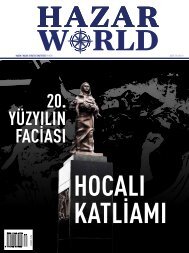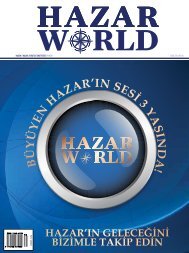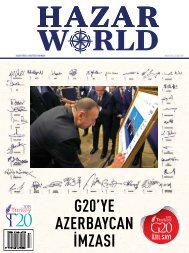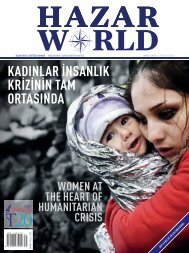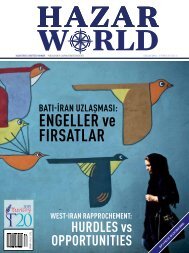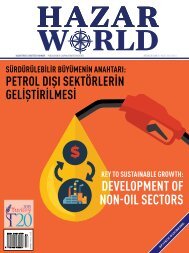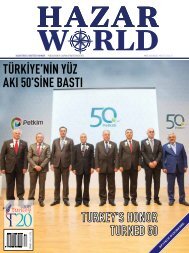Create successful ePaper yourself
Turn your PDF publications into a flip-book with our unique Google optimized e-Paper software.
www.hazarworld.com<br />
SİNEMA SANATININ TARİHİNE YOLCULUK<br />
Kırgızistan sinema sanatının tarihi üç<br />
dönemde incelenebilir:<br />
Birinci Dönem: V. Şneyderov’un etnografik-bilimsel<br />
türde yaptığı belgesel filmden<br />
başlayarak (1930) ilk uzun metrajlı kurmaca<br />
filmin çekimine kadar olan süreyi kapsar<br />
(1955).<br />
İkinci Dönem: “Saltanat” isimli ilk uzun<br />
metrajlı kurmaca filmin üretiminden (1955)<br />
Sovyetler Birliği’nin çöküşüne kadar olan<br />
süreyi kapsar (1991).<br />
Üçüncü Dönem: Bağımsız Kırgızistan<br />
Cumhuriyeti’nin kurulduğu yıldan (1991)<br />
günümüze kadar olan dönemi içine alır. Bağımsızlıktan<br />
sonraki dönem, Kırgız sinema<br />
tarihinde milli sinemanın başlangıç dönemi<br />
olarak nitelendirilir.<br />
Kırgızistan kendi sinema sanatını 1930’lu<br />
yıllardan sonra kurmaya başladı. 1928-1931<br />
yılları arasında sinema seyyahı olan U.<br />
Şveyderov Kırgızistan Cumhuriyeti konulu<br />
iki adet etnografik-bilimsel film çekti. Bunlar<br />
“Ölüm Tabanı” ve “4500 Metre Yükseklikte”<br />
isimli filmlerdir. Bu yapıtlar Kırgız belgesel<br />
filmciliğinin başlangıcı olarak kabul edilir.<br />
1917 Ekim Devrimi her alanda olduğu gibi<br />
sinema alanında da yeni yaratıcık arayışları<br />
için geniş imkanlar açtı. “Sovyet devleti kendi<br />
sinemasına belgesel filmlerden başlamalıdır”<br />
önerisinde bulunan Lenin, sinemanın<br />
gelişmesi için her türlü yardımı sağladı. Ve<br />
böylelikle Sovyet sinemasında belgesel filmcilik<br />
doğmaya ve gelişmeye başladı.<br />
02<br />
01<br />
01<br />
V. Şneyderov.<br />
V. Shneyderov.<br />
02<br />
4500 Metre Yükseklikte.<br />
4500-Meter High.<br />
09-10<br />
“Abay’ın Şarkısı” (1945)<br />
09-10<br />
“Song of Abai” (1945)<br />
A JOURNEY TO THE HISTORY OF CINEMA<br />
History of cinema in Kyrgyzstan can be<br />
divided into three periods:<br />
First Period: Consists of the period from<br />
the first ethnographic-scientific documentary<br />
film made by V. Shneyderov (1930) until<br />
the first full-length fiction film (1955).<br />
Second Period: Consists of the period<br />
from the first full-length fiction film<br />
“Saltanat” (1955) until the collapse of the<br />
Soviet Union (1991).<br />
Third Period: Consists of the period from<br />
the establishment of independent Republic<br />
of Kyrgyzstan (1991) until today. The period<br />
after independence is regarded as the beginning<br />
of the history of Kyrgyz cinema.<br />
The art of cinema started to develop in<br />
Kyrgyzstan after 1930s. V. Shneyderov –a<br />
cinema traveler from 1928 to 1931– made<br />
two ethnographic-scientific films about the<br />
Republic of Kyrgyzstan. These films are<br />
“Death Ground” and “4500-Meter High”.<br />
These works are regarded as the first productions<br />
of the Kyrgyz documentary film<br />
industry.<br />
1917 October Revolution brought forward<br />
new opportunities and new ideas for the<br />
cinema industry as in all other industries.<br />
Lenin said, “The Soviet state should build<br />
its art of cinema upon documentaries.” He<br />
cleared the way for developing cinema, and<br />
then the documentary film industry started<br />
to emerge and grow in the Soviet cinema.<br />
In the first years of the revolution, developing<br />
national cinemas in republic states was<br />
highly important. In those years, national<br />
cinemas came forward in Central Asian<br />
<strong>HAZAR</strong> <strong>WORLD</strong><br />
47







